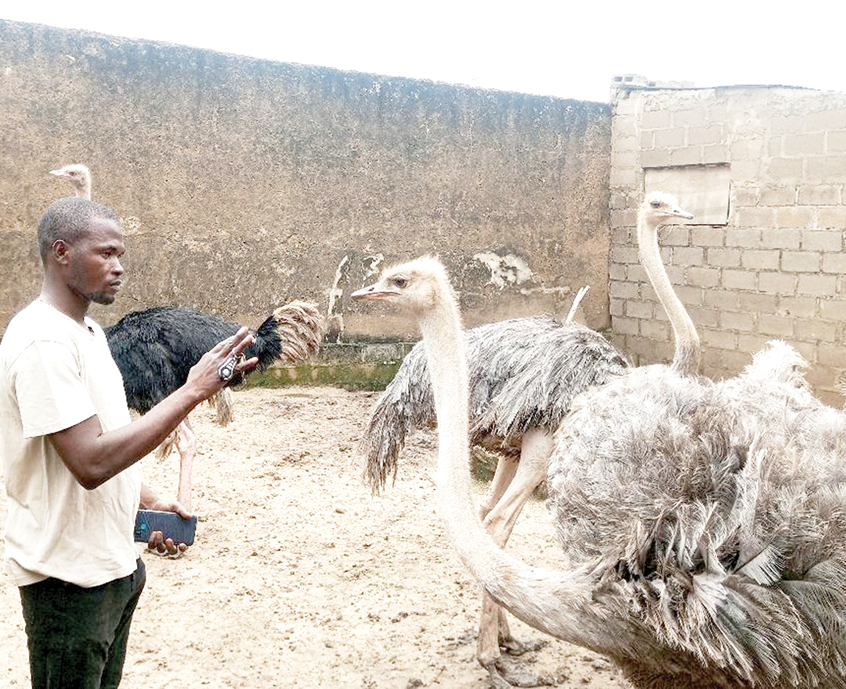Inside Kano’s lucrative ostrich farm, where chick costs N250,000
Ostrich farming is considered to be for luxury seekers alone as many are of the view that it does not attract gains; hence it is regarded as hobby for the rich, not business. Ostriches are large birds that don’t fly. They are considered to be the heaviest birds on land and also lay the largest […]

Musa, the young Kano Ostrich farmer
Ostrich farming is considered to be for luxury seekers alone as many are of the view that it does not attract gains; hence it is regarded as hobby for the rich, not business.
Ostriches are large birds that don’t fly. They are considered to be the heaviest birds on land and also lay the largest eggs as land animals.
History has shown that there are two species of ostrich in the world: the common ostrich, which is native to large areas of sub-Saharan Africa, and the Somali ostrich, which is native to the Horn of Africa.
In Kano, a young farmer, Sunusi Ali Musa, said ostrich farming was very lucrative as it could pay the bills inasmuch as the practitioner followed the required guidelines. He said an intending practitioner would need a space of 20-by-30 feet that could contain two females and one male ostriches after removing them from nursery.
Kano demolitions: Police arrest 57 over looting
Why I prefer teaching Chinese kids to Nigerian children – Kano indigene
Musa, who is also a poultry incubator fabricator, explained that a starter would need to buy a two-week-old ostrich chic or a one-month-old chic, which would be kept in the nursery feeding section with feed made from maize or soybeans mixed with leaves, such as salad, cabbage and other related green leaves. It is recommended that 70 per cent to 80 per cent of its food should be leaves.
He further revealed that the chic’s feed should be monitored to avoid overweight at an early stage, which may hinder structural development.
“Raising an ostrich is in stages – from chicks, baby chicks to a grown up ostrich. Each stage has its own required space and food for effective growth to be attained. Similarly, at a point, the bird needs to be caged because it can be hostile in some cases. Also, there is the need to avoid subjecting it to some unforeseen dangers,” Sunusi said.
It was gathered that an ostrich costs between N230,000 and N250,000, while an egg costs N50,000.
However, it is believed that a farmer starts gaining at a point when the baby ostrich is about six months old because at this stage, a baby ostrich is sold at N600,000, and the price keeps increasing as it grows.
As a luxury bird, an ostrich is always in high demand by individuals for different reasons.
An ostrich farmer can raise birds for feathers; and this can be a sustainable form of livestock farming. As stated earlier, many individuals have ventured into ostrich feather business as it is used to embellish garments, especially for royalty.
Another dividend of ostrich farming is the hide in the skin of the bird, which is often used for leather making. The hide is distinctive because of its dappled appearance, marketable qualities and high yielding potential. An ostrich is capable of producing 50 square meters of leather. The distinctive appearance of the hide of an ostrich contributes to its status as a luxury commodity, with a high market value
It is equally very vital to note that ostrich eggs are equivalent in volume to over 20 chicken eggs. Also, their empty shells are often sold for decoration or craft projects, though some farmers may sell edible eggs for consumption.
Furthermore, ostrich meat is commercially available, often promoted for its leanness and similarity in taste to beef. Ostriches produce red meat that is significantly lower in fat and cholesterol than in other animals. It is important to note that ostrich meat is one of the most expensive everywhere.
Ostriches are said to have the ability to run at 70km/h, and as such, they are seen as the fastest birds on land. However, despite their size, ostriches are farmed worldwide by individuals and groups as luxury birds.
